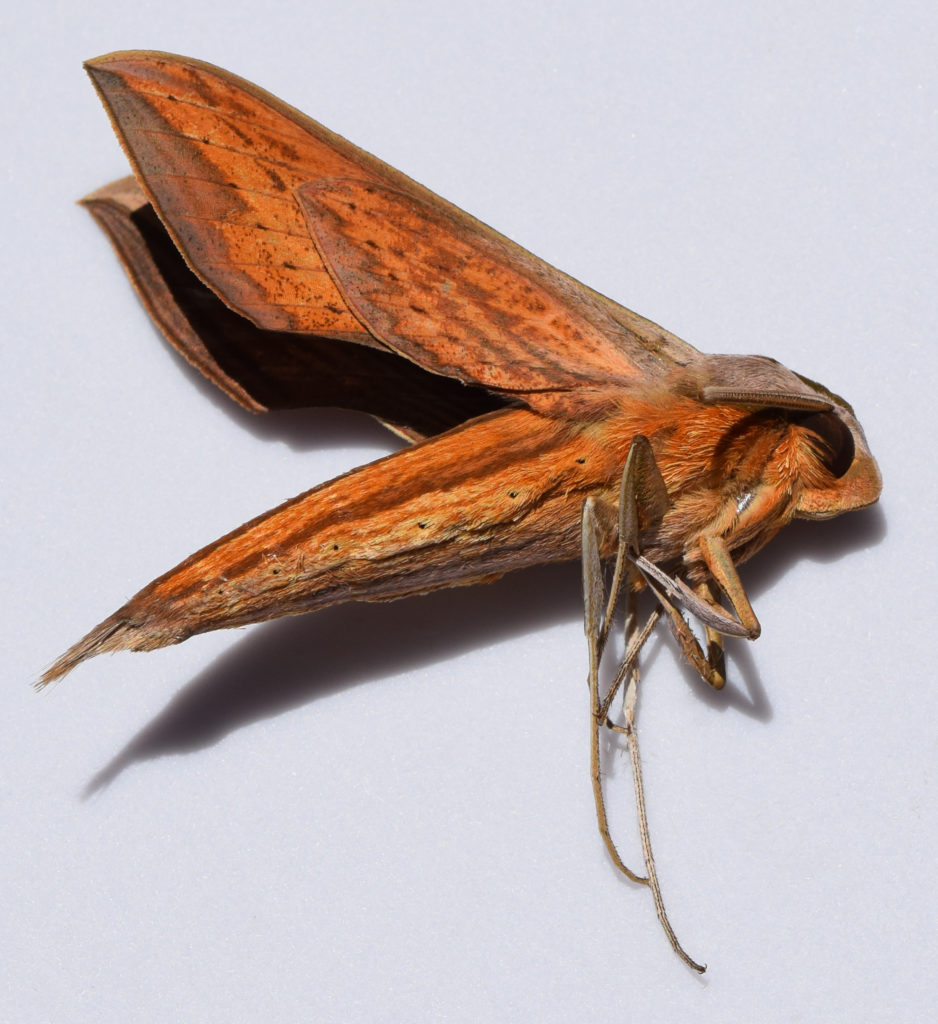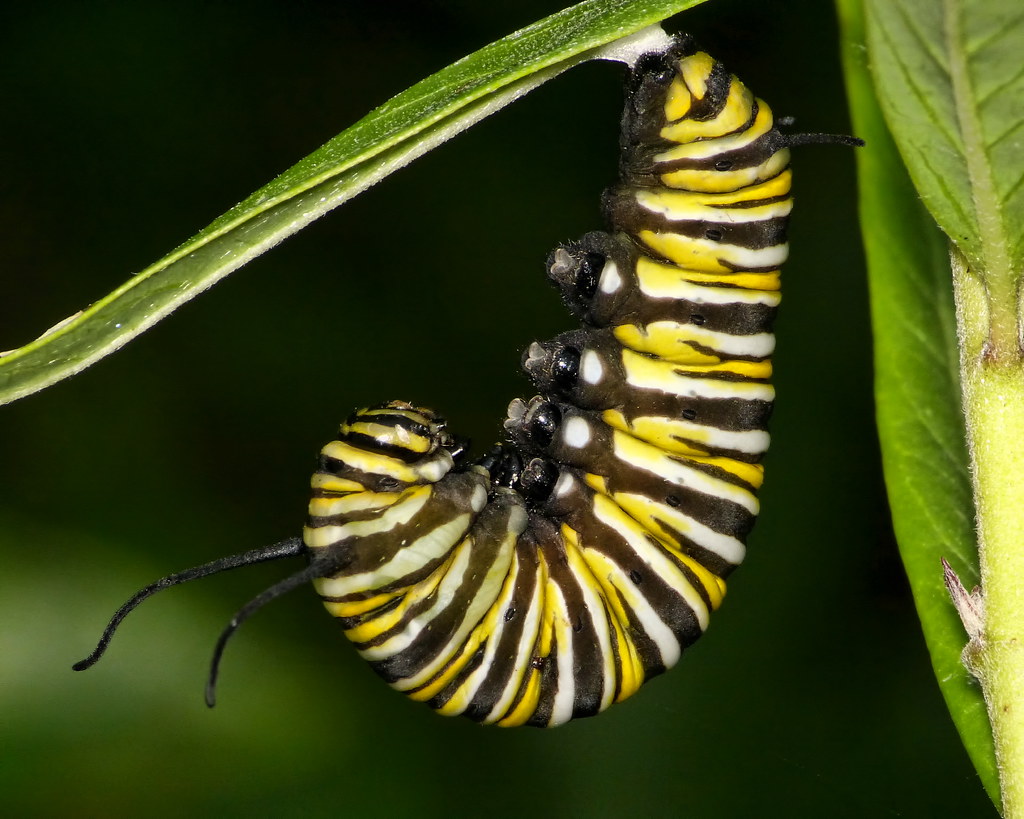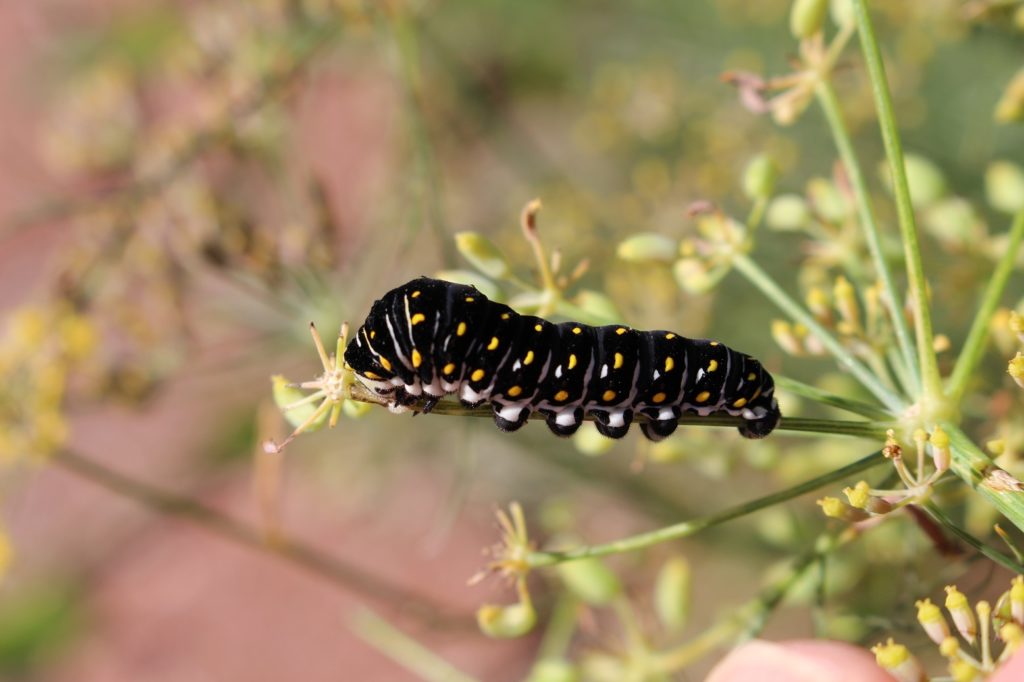We were watering Pentas earlier this week and came across this funky looking fellow (above). At first, we thought it was a more common Tomato Hornworm, but after doing some research, it’s a Tersa Sphinx (Xylophanes tersa) caterpillar! Actually, both in the photo are Tersa Sphinx caterpillars at different stages. Pretty soon they’ll transform into their beautiful moth form.

Caterpillars have been a big topic of conversation here at Gill’s this Summer; more rain than usual = more caterpillars. A good rule of thumb is to leave them alone unless you see a large congregation and they’re eating enough of a plant to cause harm. A few munched leaves here and there is not a problem. If you do get a large infestation, you can treat with organic Thuricide that only targets caterpillars.
Most different species of caterpillars are only attracted to specific host plants. Pentas are a host plant for the Tersa Sphinx, which was a big clue for identification. We know that Monarch caterpillars like milkweed, Gulf fritillary’s host plant is Passion Vine, and Swallowtail caterpillars like Rue and Dutchman’s Pipe Vine.



Once caterpillars reach their butterfly or moth form, they feed on nectar from a broader variety of South Texas plants like Lantana, Zinnia, Mist flowers, Turk’s Cap, and lots more. So, it’s a good idea to plant host plants and nectar plants together to enjoy the caterpillar’s full life cycle.

-Jesse



Cristina says
I’m new to Texas and this morning found 100’s of small orange fuzzy (i assume caterpillars) on my live oak. I appear to be the only one on my street with them. Your advice would be greatly appreciated!
Jesse says
Hi Cristina – not to worry! Their life cycle is only about 2 weeks. They will not affect the health of the tree, and they’ll be good food for birds. If you decide they’re too much of a nuisance, you could spray with organic BT. Or you could just wait them out.
Jesse says
Hi Jeri – a big infestation like you’re describing sounds like it’s time to spray organic BT, a naturally occurring bacteria that targets caterpillars. BT will take care of the caterpillars and not harm you or your tomatoes or blueberries. If you understandably don’t want to harm the caterpillars, then try relocating them. Plant or look for another food source somewhere far away and collect them all and relocate.
Jeri says
This is the very first year I have grown cherry tomatoes from seeds, organic seeds. I bought one 6 inch tomato plant also and it has been the “only” one where tomatoes turned red, all the rest are green and infested with green caterpillars, 9 plants that they have almost eaten every leaf. I’m hoping for beautiful butterflies ???? but there are very few leaves for them to eat as there are many caterpillars, what should I do? Add another food source? Carefully move them to a tree, I’m not willing to give up my new blueberry bushes.
Whitney says
I have three Xylophanes tersa (Sphinx moth) caterpillars who have formed pupae. They have been in the pupal stage for 11 days in soil in a homemade terrarium. Because we’re under a severe heat warning, they are inside at normal room temperature instead of out in the heat. Do you have any idea how long it will take before they emerge? This is a project for me and my children, and we can’t wait to see the adult moths. I’m assuming 3-4 weeks until adults, unless I’m wrong and we will be waiting until spring!
Jesse says
Cool project! We typically say 10-14 days before they emerge. This could vary since they are indoors.
Kathi says
Thank you for sharing all the info on caterpillars! I began planting milkweed a few years ago for the sole purpose of hosting the monarchs. I love scouring my plants for the eggs, the caterpillars and then searching high and low for the chrysalis and waiting anxiously for the butterflies to emerge. I let them set their chrysalis wherever and it’s always a surprise where I find them if I find them at all. Sometimes I don’t even see them until they have emerged! Great info!
Ann says
I question your statement that monarchs only eat milkweed. I have donated many “non-milkweed” plants to the monarchs and queen butterflies. They love my parsley and devour it every year. I think they eat what is available.
Jesse says
Hi Ann – that’s interesting that they are eating parsley! And you’re right, I shouldn’t have said “only”. Will make that correction.
Susan Krzeszewski says
HI Jesse, The swallowtail caterpillar, in it’s later instars have similar coloration of the monarch. black swallowtail eat parsley, rue and fennel. At a quick glance they may be confused.
Louise Chambers says
The photo labeled Monarch is actually a Queen caterpillar, a close relative of the Monarch – they also eat milkweeds. Thanks for sharing information on caterpillars, raising them is a great project for gardeners, kids, and nature lovers.
Jesse says
Hi Louise – you’re right! Thanks for noticing – we’ll find a good monarch pic
Ricky says
Hi, Louise. You obviously know your stuff. Question: I’ve 3 tent caterpillar-looking ones eating my penta. Any advice?
Thx in advance,
~Rick
laurel lindblom says
Help!!! Monarch Caterpillars have eaten the Milkweed to sticks. I have 7 in my kitchen, in a plastic box eating Butternut squash. When do I let then go? When they start climbing to get out? Something has destroyed my Mist Flower, but I don’t care. I worry about my Monarch babies!!! Help!!
Jesse says
Hi Laurel – try setting the box out on a shaded patio and they’ll leave on their own
Charlene says
Sooo they destroyed my Pentas so will they come back?
Jesse says
Hi Charlene – yes, they’ll come back. The caterpillars just cut them back for you 🙂